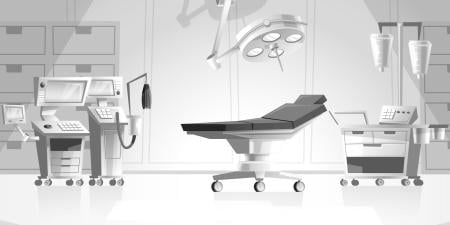There is little debate that pediatricians in training must learn to perform life-saving procedures. The crucial task is to find the optimal balance between the educational needs of trainees and safe, efficient patient care. Allowing a trainee to perform a procedure increases the risk of complications for the patient. Indeed, many feel that it is inappropriate to allow an inexperienced trainee to perform a procedure for the first time in a high-risk situation, such as the care of a critically ill child. Others argue that, unless we allow trainees such practice, we will have fewer and fewer clinicians able to perform life-saving procedures competently.
But does evidence from the literature demonstrate that there is a tradeoff between optimal patient care and future competence, that one can only happen at the expense of the other? How do we ensure the highest safety of the patient while ensuring that trainees get the necessary educational experience in the care of critically ill children? In this article, we attempt to answer this question and describe some of the emerging technologies that may facilitate the achievement of competency in pediatric trainees, while promoting a greater level of safety for the patient.
Since the introduction of the duty-hour limits by the Accreditation Council for Graduate Medical Education (ACGME) in 2001, concern has arisen that residents and fellows may not be getting as much training in procedural skills as they once did. Although this was not found to be the case for pediatric surgery trainees [1], it is generally felt that trainees in the nonsurgical subspecialties, such as general pediatrics, are performing fewer procedures.
No studies quantifying procedural experience before and after the introduction of duty-hour restrictions could be identified, but a recent study performed in the pediatric intensive care unit (PICU) at Children’s Hospital of Philadelphia (CHOP) suggests that trainees may not have enough opportunities to perform procedures. The PICU at CHOP is a large, 45-bed tertiary PICU. During the 14-month study period, 180 orotracheal intubations were performed. Of these, 64 were performed by some of the 68 pediatric and emergency medicine resident trainees rotating through the PICU [2]. Therefore, even in a large, high-volume tertiary care hospital, some trainees do not have a chance to perform even one orotracheal intubation during their PICU rotation, highlighting the scarcity of opportunities. This scarcity is partly due to the infrequent need for some interventions, but also partly to the presence of nurse practitioners, physician assistants, and subspecialists such as interventional radiologists or pediatric surgeons who may be asked to perform many of the procedures in the PICU.
Even when trainees have a chance to perform the number of procedures recommended by the certifying board, they may not feel comfortable in their abilities. A study of trainees in internal medicine [3] suggested that, to feel comfortable about their abilities, trainees need to perform more procedures (central line placement, knee joint aspiration, lumbar puncture, and thoracentesis) than the American Board of Internal Medicine recommends [4].
Requirements
The ACGME requires that general pediatric trainees must have “sufficient training in the following skills” related to critically ill children:
- basic and advanced life support
- endotracheal intubation
- placement of intraosseous lines (demonstration in a skills lab or Pediatric Advanced Life Support [PALS] course is sufficient)
- placement of intravenous lines
- arterial puncture
- venipuncture
- umbilical artery and vein catheterization
- lumbar puncture
- bladder catheterization
- procedural sedation
- pain management
and “exposure to the following procedures or skills” related to the critically ill child:
- chest tube placement
- thoracentesis
However, no minimum number of times performing each procedure is specified to meet this requirement [5].
The American Board of Internal Medicine (ABIM) does not require a minimum number of times either, but suggests that a trainee should be involved in each a minimum of five times [4]. Internal medicine trainees are required by the ABIM to demonstrate proficiency in a selected subset of procedures, including advanced cardiac life-support resuscitation, the drawing of arterial and venous blood, pap smears and endocervical cultures, and placement of a peripheral venous line. For the rest of the procedures, trainees only need to be able to demonstrate their knowledgeof components such as indications, complications, and what information patients need to give informed consent. The ABIM suggests that medical simulation be used as the initial step in procedural training.
The ABIM further recommends that trainees who will be performing a procedure independently should be thoroughly evaluated and credentialed before doing so [4]. In the era of specialization, while all pediatric trainees should learn a minimum set of effective life-saving procedures, training in advanced skills such as endotracheal intubation and central line placement should be reserved for those who are specializing in emergency medicine, neonatology, anesthesia, and critical care.
Recommendations
Given the limitation in clinical opportunities for residents just described, we advocate that general pediatric trainees should, at a minimum, be competent in the performance of procedures necessary to stabilize a critically ill child until more specialized help arrives. This includes providing successful bag-mask ventilation, placing an intraosseous needle and intravenous catheter for vascular access, drawing arterial and venous blood, and performing pediatric resuscitation according to standard guidelines, i.e., Pediatric Advanced Life Support (PALS) or Advanced Pediatric Life Support (APLS).
General pediatric residents should have adequate knowledge to describe and understand the protocols and possible complications of more specialized procedures such as endotracheal intubation and central venous line (CVL) placement, but should not be required to perform them during generalized training. This would reserve opportunities to perform specialized procedures for trainees who will be expected to perform them independently as part of their clinical practice, such as pediatric fellows subspecializing in critical care. Even specialized trainees may never have the opportunity to practice procedures such as pericardiocentesis on a patient during their training because these situations are relatively infrequent and the context is often life-threatening.
To compensate for the limitations in training opportunities for pediatric residents, some have suggested allowing residents to perform procedures on patients undergoing cardiopulmonary resuscitation (CPR) or on the newly deceased. Kaldijan and colleagues argue that performing nontherapeutic procedures on patients during CPR is not consistent with ethical standards and that procedures should only be performed during CPR if they are medically indicated, the trainee is adequately supervised, and informed consent has been given [6].
The use of newly deceased patients for procedural training also requires special consideration. Burns and Truog have advocated that newly deceased patients may be used to practice nonmutilating procedures by trainees who need to acquire the procedural skills to fulfill their clinical role responsibilities, but only after appropriate conceptual training about the procedure has been completed and the family has given informed consent [7].
After determining which procedures pediatric trainees need to learn and which clinicians need to develop competency in additional skills to care for the critically ill child, training strategies must be developed and employed to educate trainees efficiently and safely. The traditional “see one, do one, teach one” approach is no longer practical or sufficient. Other educational modalities can ensure a basic understanding and proficiency of the necessary procedures before the trainee touches a live patient.
We advocate a structured learning strategy that uses computer-based learning, task trainers, and high-fidelity simulation to demonstrate the conceptual and technical fundamentals of procedures, followed by observing and performing procedures on healthy adults and children in the operating room or other elective situations, before a trainee attempts to perform a procedure on a critically ill child.
Computer-based instruction can provide essential information about a clinical intervention, including its indications, required equipment, and procedural steps. This instruction can be delivered through printed text and images, video and animations, or, less commonly, a simulated patient experience. The New England Journal of Medicine has a repository of procedural videos on its website [8]. Computer-based learning has been shown to be as effective as traditional methods in teaching ultrasound guided CVL placement [9], adherence with sterile technique for CVLs [10], and difficult airway management [11].
After instruction in fundamentals, task trainers and simulation may then be employed to teach trainees such technical skills as peripheral intravenous and central venous catheterization. As computer technology becomes increasingly sophisticated, more realistic interactive simulations are emerging, including devices that can detect motion in three dimensions, such as Nintendo’s Wii controller. At Games for Health 2010, Gredel Games demonstrated a prototype laparoscopic trainer that uses Wii technology [12].
Many studies have demonstrated that use of simulation improves skills in the clinical environment. For example, simulation training was shown to improve CVL placement technique [13, 14] and reduce complications from CVL placement [15]. Intensive simulation courses at the start of residency programs (so-called boot camps) have been shown to improve overall procedural knowledge and clinical skills [16-19].
Several studies, however, report that improvement in skills during simulation does not translate into improvement in clinical situations [2, 20]. In some cases, trainees felt more confident about their procedural skills after a simulation experience, but this was not borne out by their actual performance during the simulation [21]. Controlled patient experiences may help translate skills learning in simulation exercises into the clinical environment in a safe manner. These encounters may involve real patients in elective situations with adequate supervision by experienced clinicians. Intubation skills have been successfully acquired by medical students in this manner during their anesthesia rotations [22].
Conclusion
Evolving demands in health care require new methods of training, especially when it comes to the skills needed to care for critically ill patients. Training physicians requires no tradeoff with optimal patient care; the former goal can be met without negatively impacting the latter. But both goals can only be accomplished by developing a comprehensive program based on evidence from the literature about safe and effective training in life-saving procedures.
All pediatric trainees must acquire basic life-saving procedural skills, while opportunities to practice advanced critical care procedures such as endotracheal intubation and central line placement should be reserved for clinicians who will perform those procedures independently on critically ill children. Given the limited opportunities for experience and the availability of new educational modalities in most training programs, computer-based learning and simulation should be used to teach conceptual and technical fundamentals, followed by closely supervised, controlled patient experiences and, finally, real patient encounters.
References
- Simien C, Holt KD, Richter TH. The impact of ACGME work-hour reforms on the operative experience of fellows in surgical subspecialty programs. J Grad Med Educ. 2011;3(1):111-117.
- Nishisaki A, Donoghue AJ, Colborn S, et al. Effect of just-in-time simulation training on tracheal intubation procedure safety in the pediatric intensive care unit. Anesthesiology. 2010;113(1):214-223.
- Hicks CM, Gonzales R, Moton MT, Gibbons RV, Wigton RS, Anderson RJ. Procedural experience and comfort level in internal medicine trainees. J Gen Intern Med. 2000;15(10):716-722.
-
American Board of Internal Medicine. Internal medicine policies. http://www.abim.org/certification/policies/imss/im.aspx. Accessed on July 8, 2012.
-
Accreditation Council for Graduate Medical Education. ACGME program requirments for graduate medical education in pediatrics; 2007. http://www.acgme.org/acWebsite/downloads/RRC_progReq320_pediatrics_07012007.pdf. Accessed on July 8, 2012.
- Kaldjian LC, Wu BJ, Jekel JF, Kaldjian EP, Duffy TP. Insertion of femoral-vein catheters for practice by medical house officers during cardiopulmonary resuscitation. N Engl J Med. 1999;341(27):2088-2091.
- Burns JP, Reardon FE, Truog RD. Using newly deceased patients to teach resuscitation procedures. N Engl J Med. 1994;331(24):1652-1655.
-
New England Journal of Medicine. Videos in clinical medicine. http://www.nejm.org/multimedia/medical-videos. Accessed on July 15, 2012.
- Chenkin J, Lee S, Huynh T, Bandiera G. Procedures can be learned on the Web: a randomized study of ultrasound-guided vascular access training. Acad Emerg Med. 2008;15(10):949-954.
- Xiao Y, Seagull FJ, Bochicchio GV, et al. Video-based training increases sterile-technique compliance during central venous catheter insertion. Crit Care Med. 2007;35(5):1302-1306.
- Bello G, Pennisi MA, Maviglia R, et al. Online vs live methods for teaching difficult airway management to anesthesiology residents. Intensive Care Med. 2005;31(4):547-552.
-
Barad J. Games For Health 2010: “Disney-esque” laparoscopy game to train our surgeons of tomorrow… today! MedGadget. May 27, 2010. http://medgadget.com/2010/05/games_for_health_2010_disneyesque_laparoscopy_trainer_to_train_our_surgeons_of_tomorrow_today.html. Accessed on July 7, 2012.
- Barsuk JH, McGaghie WC, Cohen ER, Balachandran JS, Wayne DB. Use of simulation-based mastery learning to improve the quality of central venous catheter placement in a medical intensive care unit. J Hosp Med. 2009;4(7):397-403.
- Evans LV, Dodge KL, Shah TD, et al. Simulation training in central venous catheter insertion: improved performance in clinical practice. Acad Med. 2010;85(9):1462-1469.
- Barsuk JH, McGaghie WC, Cohen ER, O’Leary KJ, Wayne DB. Simulation-based mastery learning reduces complications during central venous catheter insertion in a medical intensive care unit. Crit Care Med. 2009;37(10):2697-2701.
- Fernandez GL, Page DW, Coe NP, et al. Boot cAMP: educational outcomes after 4 successive years of preparatory simulation-based training at onset of internship. J Surg Educ. 2012;69(2):242-248.
- Parent RJ, Plerhoples TA, Long EE, et al. Early, intermediate, and late effects of a surgical skills “boot camp” on an objective structured assessment of technical skills: a randomized controlled study. J Am Coll Surg. 2010;210(6):984-989.
- Malekzadeh S, Malloy KM, Chu EE, Tompkins J, Battista A, Deutsch ES. ORL emergencies boot camp: using simulation to onboard residents. Laryngoscope. 2011;121(10):2114-2121.
- Nishisaki A, Hales R, Biagas K, et al. A multi-institutional high-fidelity simulation “boot camp” orientation and training program for first year pediatric critical care fellows. Pediatr Crit Care Med. 2009;10(2):157-162.
- Finan E, Bismilla Z, Campbell C, Leblanc V, Jefferies A, Whyte HE. Improved procedural performance following a simulation training session may not be transferable to the clinical environment. J Perinatol. 2012;32(7):539-544.
- Tofil NM, Benner KW, Zinkan L, Alten J, Varisco BM, White ML. Pediatric intensive care simulation course: a new paradigm in teaching. J Grad Med Educ. 2011;3(1):81-87.
- Tarasi PG, Mangione MP, Singhal SS, Wang HE. Endotracheal intubation skill acquisition by medical students. Med Educ Online. 2011;16



